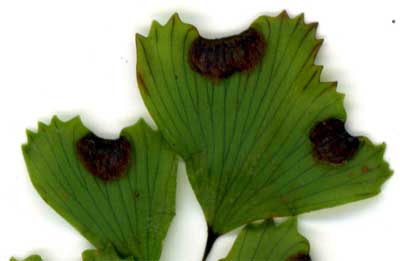|
Hardy Fern Home A. monochlamys resources
All Ferns Pteridaceae Adiantum
Other Genera |
| Adiantum monochlamys | ||
|
Etymology
Mono signifies single; chlamys recalls a kind of cloak worn by the ancient Greeks.
Description
Rhizome: short-creeping, 4 mm diam., clump-forming, scales linear to linear-lanceolate, dark brown.
Frond: 40 cm high by 8 cm wide, deciduous, monomorphic, blade/stipe ratio: 3:2. Stipe: purplish brown to reddish brown, polished, scaly at base, glabrous in upper portion, 2 mm diam., vascular bundles: 1 or 2. Blade: 2-pinnate most commonly, but more at the base in mature specimens, ovate, with a terminal pinna similar to the terminal pinnules of the pinnae, papery, glabrous. Pinnae: 4 to 6 pair, lanceolate, to 4 cm, anadromous in plan; pinnules wedge-shaped, to 12 mm; margins toothed at the far end; veins free, palmate. Sori: oblong, mostly solitary in the center of the upper margin of the pinnule, indusium: false, inrolled margins, reniform, sporangia: reddish-brown. Culture
Habitat: dry cliffs or rocky slopes in open forests.
Distribution: Japan, China, Korea.
Hardy to -20°C, USDA Zone 6.
Distinctive Characteristics
The single sorus may not be unique in the genus, but it is among temperate ferns.
Synonyms
Adiantum venustum var. monochlamys (Eaton) Luerss. Adiantum veitchii Hance |
|
|

Adiantum monochlamys. The one-sorus-per-segment rule is sometimes invalid on the terminal segment (pinnule). Scan: Tom Stuart |
